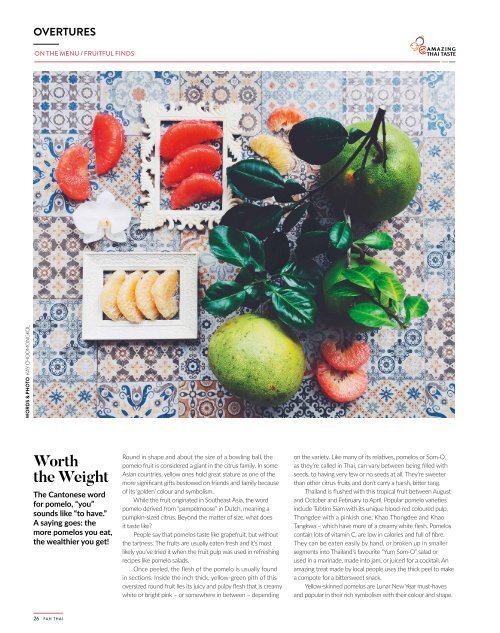Fah Thai Magazine Sep/Oct 2017
"FAH THAI" is the in-flight magazine of Bangkok Airways Public Company Limited and is edited and published by MPMI Group Ltd.
"FAH THAI" is the in-flight magazine of Bangkok Airways Public Company Limited and is edited and published by MPMI Group Ltd.
You also want an ePaper? Increase the reach of your titles
YUMPU automatically turns print PDFs into web optimized ePapers that Google loves.
OVERTURES<br />
ON THE MENU / FRUITFUL FINDS<br />
WORDS & PHOTO KAY CHOOMONGKOL<br />
Worth<br />
the Weight<br />
The Cantonese word<br />
for pomelo, “you”<br />
sounds like “to have.”<br />
A saying goes: the<br />
more pomelos you eat,<br />
the wealthier you get!<br />
Round in shape and about the size of a bowling ball, the<br />
pomelo fruit is considered a giant in the citrus family. In some<br />
Asian countries, yellow ones hold great stature as one of the<br />
more significant gifts bestowed on friends and family because<br />
of its ‘golden’ colour and symbolism.<br />
While the fruit originated in Southeast Asia, the word<br />
pomelo derived from “pampelmoose” in Dutch, meaning a<br />
pumpkin-sized citrus. Beyond the matter of size, what does<br />
it taste like?<br />
People say that pomelos taste like grapefruit, but without<br />
the tartness. The fruits are usually eaten fresh and it’s most<br />
likely you’ve tried it when the fruit pulp was used in refreshing<br />
recipes like pomelo salads.<br />
Once peeled, the flesh of the pomelo is usually found<br />
in sections. Inside the inch thick, yellow-green pith of this<br />
oversized round fruit lies its juicy and pulpy flesh that is creamy<br />
white or bright pink – or somewhere in between – depending<br />
on the variety. Like many of its relatives, pomelos or Som-O,<br />
as they’re called in <strong>Thai</strong>, can vary between being filled with<br />
seeds, to having very few or no seeds at all. They’re sweeter<br />
than other citrus fruits and don’t carry a harsh, bitter tang.<br />
<strong>Thai</strong>land is flushed with this tropical fruit between August<br />
and <strong>Oct</strong>ober and February to April. Popular pomelo varieties<br />
include Tubtim Siam with its unique blood-red coloured pulp,<br />
Thongdee with a pinkish one, Khao Thongdee and Khao<br />
Tangkwa – which have more of a creamy white flesh. Pomelos<br />
contain lots of vitamin C, are low in calories and full of fibre.<br />
They can be eaten easily by hand, or broken up in smaller<br />
segments into <strong>Thai</strong>land’s favourite “Yum Som-O” salad or<br />
used in a marinade, made into jam, or juiced for a cocktail. An<br />
amazing treat made by local people uses the thick peel to make<br />
a compote for a bittersweet snack.<br />
Yellow-skinned pomelos are Lunar New Year must-haves<br />
and popular in their rich symbolism with their colour and shape.<br />
26

















